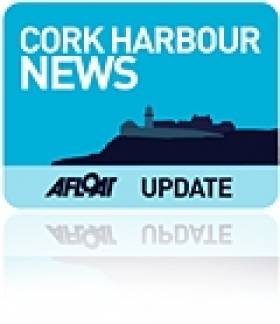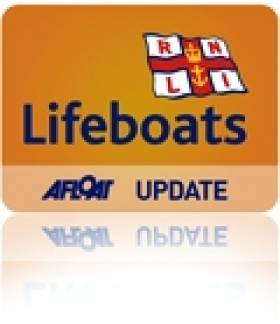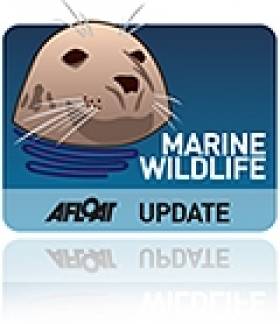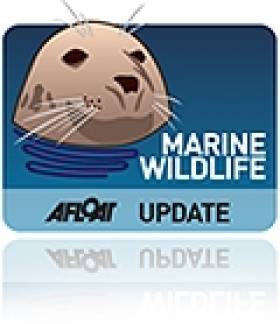Displaying items by tag: Shannon Estuary
Tricky Conditions for Shannon Estuary Cappa Race
On Saturday last with the weather favourable, members of Foynes Yacht Club raced in the annual Cappa fixture, which has been on the sailing calendar for a considerable time.
Unfortunately, the Glin Castle race was cancelled beyond Foynes Yacht Club control, but instead the Cappa race was held on Saturday instead of Sunday.
Two classes raced, Class 1 and 2. Class 1 were racing for the Cappa Cup, while Class 2 competed for the Sean Keating Trophy.
Eleven yachts 'took to the water', where Officer of the Day, Ray McGibney sent both fleets 'off' for an 11am start. A force 4 to 5 north-westerly wind made sailing quite tricky for the fleet. With the tide 'flushing' down the estuary and choppy seas made the race somewhat interesting, where the boats had to tack to reach the Clare coastal village of Cappa.
With a hard fought race and more or less neck and neck, in class 1 winners of the recent Carrigaholt cup, Battle, emerged victorious beating off John and Edward Conway in Golden Kopper, who came in second. Third was Andrew Bracken on Joyrider.
In class 2 the Sean Keating Trophy was won by James McCormack on Alphara; second was Pat Finucane on Marengo and third Jazmin 2.
A crews race back up the estuary to Cooleen Point took place, where a Bar-B-Que was held in the clubhouse afterwards, where the culinary delights of the chef's kept the hungry sailors wanting more.
Next Sunday the September series of racing will commence for all classes, and it is envisaged that all boats will be racing in their respective classes. All crew and skippers are asked to be at the club at 1pm, where a briefing will take place before racing. First gun for all races will be 2.30pm.
Club racing continues every Wednesday evening with first gun at 7pm.
Seaplane Service Makes Cork Harbour Test Flight
New Lifeboat for Shannon Estuary
Volunteers at Kilrush Royal National Lifeboat Institution (RNLI) station on the Shannon Estuary have received a new state-of-the-art lifeboat which enters service this month.
The Atlantic 85 RIB (Rigid Inflatable boat) is not only bigger and more powerful than Kilrush's existing craft but it also fitted with the latest Search and Rescue technology and instrumentation, equipping the service to continue saving lives into the next generation. Kilrush is one of only two stations in Ireland and the UK which will receive such an upgrade this year.
Following the construction of a new station in 1996, an Atlantic 21 B Class lifeboat was placed on temporary duty at the Kilrush station however it was replaced by a new Atlantic 75 lifeboat the following October. Fourteen years later, this vessel will now be replaced by the new Atlantic 85.
Kilrush Lifeboat Operations Manager John Lamb said, "This is a great vote of confidence in the crew here at Kilrush. It shows that we are doing what is being asked of us and that are being rewarded by being entrusted by this the latest in lifeboat technology and development"
The Atlantic class of lifeboats is named after Atlantic College, where the design was originally developed. Like previous RIBs, it has a manually operated self-righting mechanism, deploying an airbag mounted atop the A-frame arch. It is capable of being beached in an emergency without sustaining damage to engines or steering gear. The Atlantic 85 is fitted with radar and VHF direction finding equipment and can be operated safely in daylight in a force 6/7 and at night in a force 5/6 gale.
Related Safety posts
RNLI Lifeboats in Ireland
Safety News
Rescue News from RNLI Lifeboats in Ireland
Coast Guard News from Ireland
Water Safety News from Ireland
Marine Casualty Investigation Board News
Marine Warnings
Privatisation of the Ports Should be Strongly Opposed
In the first installment of a new weekly maritime blog on Afloat.ie, marine correspondent Tom MacSweeney says our ports are vital national assets;
It astonishes me that the Government should consider selling off the country’s ten major port companies - Dublin, Cork, Dun Laoghaire, Waterford, Shannon/Foynes, Drogheda, Galway, Wicklow, New Ross and Dundalk.
Ninety-five per cent of Irish exports and imports go by sea through our ports which are the vital entry and exit points of our transport system. To consider privatising them is an example of how unaware the Government is that Ireland is a small island community on the periphery of Europe.
The lesson of transport chaos caused by the Icelandic ash grounding aircraft this year has not been learned. It demonstrated how vital maritime transport is to this island nation.
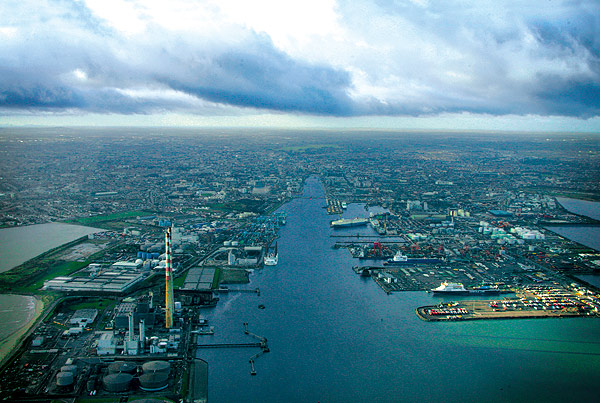
Dublin Port Company - a profitable state company
This is a smash-and-grab raid, redolent of a bankrupt Government philosophy. It is one thing to consider selling off the family jewels when, at least, the householder would still have access to the house. To sell off the ports is akin to the householder selling off the driveway, porch and front door to the house, then having to pay for the right to use them to enter the house in the future.
The Government has failed to develop a national ports policy. In the Progressive Democrat-fuelled era when privatisation, competition and profits were its driving force, the ports were moved out of direct State ownership and turned into semi-State competing bodies. Iarnrod Eireann was permitted to largely opt out of rail freight operations through the ports. Turned loose to compete against each other, the port companies followed no overall national policy for the benefit of the nation and now their future has been put in the hands of a group whose chairman advocates the sale of State companies and has already shown a lack of concern for the marine sector by shutting down the national sail training programme.
Aspects of journalism these days disappoint me after 45 years in the profession. Colm McCarthy who led Bord Snip Nua, is now chairing what is, effectively, ‘board privatisation,’ yet sections of the media seem largely to accept his views without question. I have not seen a lot of reportage which refers to his scathing opposition to the building of the DART, the Dublin Area Rapid Transport system, which he described as financial insanity and profligacy. Had those views been accepted, there would be no DART in Dublin, the consequences of which today are interesting to consider.
Privatisation of the ports should be strongly opposed. These are vital national assets. The lesson of selling-off Eircom has also, apparently, been forgotten by the Government.
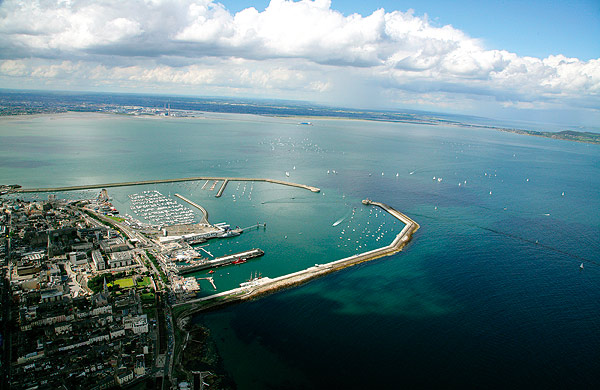
Dun Laoghaire Port on Dublin Bay
A Republic should be an entity in which there is open debate about public policy, not decision-making by elites. Flogging off our best assets, which is what this move by the Government is about, will not solve the nation’s problems. It is shocking to think that money from the sale of our vital transport arteries, the ports, could go to benefit those property speculators and banks which have bankrupted this nation.
This article is reprinted by permission of the CORK EVENING ECHO in which Tom MacSweeney writes maritime columns twice weekly. Evening Echo website: www.eecho.ie
Live Dolphin Strandings on West Coast
The Irish Whale and Dolphin Group (IWDG) have received reports of five live stranding incidents of these marine animals along the west coast between 23 July and 9 August. There was a further report of a stranded striped dolphin from the Shannon Estuary Co. Clare on 9 August which, although dead when found, may also have live stranded. Pictures on the IWDG Website HERE.
Should a bather step on a weever fish then the pain is excruciating as the spines embed into the human flesh and discharge their poison. (SEE RELATED VIDEO BELOW)
The pain is at its most intense for the first two hours when the foot normally goes red and swells up, and then it may feel numb until the following day with irritation and pain that may last for up to two weeks. Sometimes, the spine breaks off in the foot and it will cause discomfort until it is removed. You won't see a Weever fish easily but you will know it's there if you are unfortunate enough to stand on one since its back has a defensive sting mechanism. The sting can be very painful but will not cause permanent damage.
The poison is a type of protein and is heat labile. Most reports of stings occur during the month of August. This does not mean that this fish are particularly prevalent inshore during this month but merely reflects the greater numbers of bathers as the sea temperature reaches the highest of the year. The only death on record after someone being stung by a Weever occurred as long ago as 1927, when an angler suffered multiple stings whilst fishing off Dungeness in the UK.
The mouth itself is in an unusual position on its head, oblique and almost vertical and contains some of the most sharp and vicious looking teeth in the undersea world. Luckily it only reaches about 15 cm long.
The Weever has to be quick to catch is prey though, and for half a metre it has a fair turn of speed, before sinking to the sea floor. This fish does not have a swim bladder, the device used by most bony fish to keep buoyant.
The species found in shallow waters is called the Lesser Weever with the scientific name of Echiichthys vipera. There is a larger species called the Greater Weever, Trachinus draco, found in deeper water and occasionally seen on the fishmongers slab. The word 'weever' was first found used in the English language during the 17th century and comes from the Old northern French word 'wivre'.
One danger is that it can cause anaphylactic shock or allergic reaction and people have been known to die.
People who have been stung should take painkillers and if they develop an allergic reaction to the sting, a course of antihistamines is recommended
Seek assistance from a lifeguard who are all qualified first aiders.
Aspivenin syringes can painlessly draw out poison from the wound.
If you are away from a beach with lifeguard support, as soon as possible get the area which has been stung, invariably the foot, into hot water, this increases the blood flow which assists natural cleaning and healing, the heat also helps to breakdown the poison. The water needs to be over 40 degrees Celsius to be of any benefit in breaking down the poison.
New Workboat For Shannon Estuary
Delivery of the vessel from Mooney Boats in Killybegs was down along the West Coast of Ireland, up the Shannon estuary and through the twin locks at Ardnacrusha, to its new work place on the Lower Shannon. The Inis Muilinn is the second new vessel to enter service on the Shannon. The larger Inis Cealtra workboat commenced service on the North Shannon in 2009.
Specially designed for towing operations on inland waterways, the Inis Muilinn has a shallow draught and powerful 320hp engine to enable it tow and manoeuvre pontoons and sections of floating moorings to various locations along the Shannon. The access basket attachment for the deck crane enables ready and safe access to high navigation markers and bridges along the waterways.
Designed as a multi-purpose workboat/tug, the Inis Muilinn is equipped with a Caterpillar C7 320hp engine and quick-shift Twin Disc gearbox,13 kVA Generator, Guerra deck crane and remote controlled man access basket, hydraulic bow thruster and a suite of electronic equipment including chart-plotter, radar and radio equipment. Environmentally friendly sealed tube coolers are used on both the main engine and generator. The substantial tube cooler supplied by Klima for the main engine is designed to enable the boat to operate at maximum power when travelling against the strong winter flows encountered on the Shannon.
The Inis Muilinn is a further addition to a fleet of more than 60 boats owned and operated by Waterways Ireland staff in the management and maintenance of the waterways under its remit.
The Inis Muilinn was designed and built to Waterways Irelands specification by Mooney Boats of Killybegs and their naval architects, Marine Design International. The vessel is constructed and certified to the meet the regulatory requirements of the Marine Survey Office (Dept of Transport).

Dempsey Confirmed Winner with Race to Spare
The new champion has previously won Mermaid Week in 1987 and again in 2000, sailing his own boat No. 36 Elizabeth. Paul Winter's boat, No. 183 Wannago has won Mermaid Week once before, in Fenit in 2002, helmed by her builder and former owner Sam Shiels.
The winner of the Daphne (Silver fleet, 12 boats) was Geraldine O'Neill in 73 Lively Lady crewed by her husband Mick Hanney (President of Mermaid Sailing Association) and Ailbhe Smith. O'Neill, like Dempsey didn't have to sail on the last day to secure the trophy.

The Mermaid Start for Race 6 today in a 22 knot breeze on the Shannon Estuary
The Designer (Bronze fleet, 23 boats), unlike the others was down to the bitter end with Mark McCormack (54 Hycilla) and Paddy Archer (18 Clare) being the main contenders. But retirements of 54 and 18 due to gear failure in squalls allowed Mark Boylan of Skerries (177 This is It) sailing a boat built by his grandfather Joe to achieve overall victory.
Overall results:
1st 183 Wannago Owner Paul Winters, Helm Jim Dempsey, Crew Cian O'Regan and Scott Flanagan of Skerries - 8 points
2nd 123 Vee Owner & Helm, Jim Carthy, Crew Paula & Muriel Carthy of Rush - 13 points
3rd 131 Wild Wind Owner & Helm, Paddy Dillon, Crew Johnny Dillon & Rory Grimes of Rush- 13 points
4th 188 Innocence Owner & Helm, Anthony Carthy, Crew Marguerite Carthy and Eoin Butterly of Rush - 24 points
5th 187 Zuleika Owner & Helm, Derek Joyce, Crew Cillian Joyce and Darragh Hassey of Wexford - 29 points
6th 135 Cara II Owner & Helm, Frankie Browne, Crew Marina & Frankie Browne Jnr of Skerries - 30 points
Daphne - 73 Lively Lady Owner & Helm Geraldine O'Neill, Crew Mick Hanney, Ailbe Smith of National Yacht Club
Designer - 177 This is It Owner Joe Boylan, Helm Mark Boylan, Crew Niall Collins & Graham Daly of Skerries
Dempsey Declared Mermaid Champion with Race to Spare
Jonathan O'Rourke's No.77 Tiller Girl won today, leading the fleet the for the first half and then tussling with No 187 Zuleika for the 2nd half, eventually winning out on the last beat. There was considerable place swapping further down in the fleet. Of particular interest is the four McCormack boats competing for the Munster trophy. Brothers James and Vincent, and James' sons Darragh and Mark are competing in their four Mermaids and all in the running for the Munster trophy (9 boats eligible). They went around the 2nd leeward mark in a raft today, though without troubling the protest committee. It looks like it will be down to the last beat on the last day (tomorrow, Race 6).
The new unofficial champion has previously won Mermaid Week in 1987 and again in 2000, sailing his own boat No. 36 Elizabeth. Paul Winter's boat, No. 183 Wannago has won Mermaid Week once before, in Fenit in 2002, helmed by her builder and former owner Sam Shiels.
The unofficial winner of the Daphne (Silver fleet, 12 boats) was Geraldine O'Neill in 73 Lively Lady crewed by her husband Mick Hanney (President of Mermaid Sailing Association) and Ailbhe Smith. O'Neill, like Dempsey doesn't have to sail tomorrow to secure the trophy.
The Designer (Bronze fleet, 23 boats), unlike the others will be down to the bitter end with Mark McCormack (54 Hycilla) and Paddy Archer (18 Clare)being the main contenders.
All of the above is provisional information as Protest Time is still open for Race 5 until 20:41 this evening and overall championship results will not be confirmed officially until after 17:00 on Friday 6th August.
For the first time this year, the Mermaid Sailing Association and Foynes Yacht Club have been running a live blog during racing with updates every few minutes from the committee boat, supported by analysis from the race office. Live photos are also posted on the blog, including contentious start lines and boat on boat action. In today's racing over there were over 700 views of the blog and more than 100 on line at www.dublinbaymermaid.org/foynes2010 <http://www.dublinbaymermaid.org/foynes2010> simultaneously.
Mermaid Week concludes tomorrow with Race 6. 33 boats are competing. Follow the Live Commentary at for news of any protest this evening and during racing tomorrow from 13:00.
Racing Continues Apace at Mermaid Week
Race 3 of the National Mermaid Championship starts today at 15:00, followed by the annual 'crew' race. Five times champion Derek Joyce in 187 Zuleika has a major challenge to stay in the running and really needs a win to stay in contention. The stiffer breezes foretasted today should suit him. Another boat with some work to do is 131 Wild Wind, sailed by last year's champion Paddy Dillon; as he is lying third overall at seven points, he needs to stay in the top three today.
Yesterday's winner, Shay O'Toole (182 Dolphin) is lying 6th overall and another win today could put him in contention for the Championship. Current overall leader Jim Dempsey (183 Wannago), with two seconds under his belt, needs to maintain consistency as four times champion Jim Carthy (123 Vee) is hot on his heels just one point behind.
Of the 186 Mermaids built since 1932, some have been built by professionals and some by amateurs. Amateur is, perhaps not the best word as many Mermaid sailors are carpenters, furniture makers and woodwork teachers by profession and have build fast boats to exacting standards. The most prolific builders over the years have been John Brennan of Dun Laoghaire (16 boats), James Kearney (15 boats) and Skee Gray (10 boats).
Of the thirty three boats competing this week, Brennan built three, Harry & Tom Grieves built three and Des Tyrell built three. Four sailors are on board boats they built themselves: Frankie Browne (135 Cara II), Martin O'Toole (179 Bean Adhmaid), Shay O'Toole (182 Dolphin) and Ross Galbraith (185 The Message). Former champion Joe Boylan built the boats being sailed by his son Aidan (138 Zeila) and grandson Mark (177 This Is It).
If there was a Formula 1 style 'Constructor's Championship', the top three builders since 1953 would be: Harry & Tom Grieves, 9 wins; John Brennan, 8 wins and Des Tyrell, 7 wins. This year the Grieves boats are 73 Lively Lady, 76 Helen and 77 Tiller Girl. The Brennan boats are 131 Wild Wind, 143 Jill and 146 Fugitive, while the Tyrell boats are 186 MyDi, 187 Zuleika and 188 Innocence. It's all to play for.
Live updates will be blogged from the race area today at http://www.dublinbaymermaid.org/foynes2010/index_files/Commentary.htm.



























